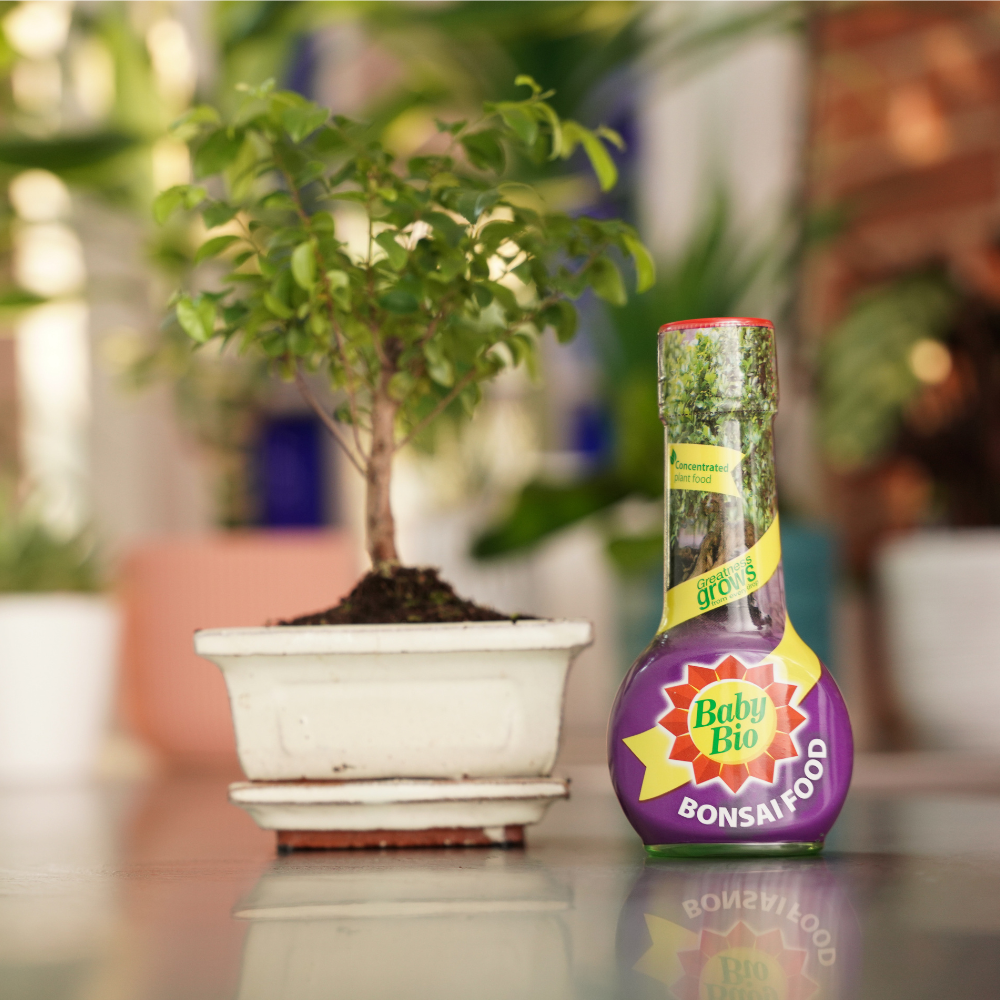
Effective bonsai tree care
Bonsai tree care needn’t be a chore; check out our guide to healthy and thriving bonsai trees below!
Symbolising harmony and peace, bonsai trees make a beautiful addition to any interiors, bringing serenity and style to any small space. Believed to welcome positive feng shui and re-energise your home, these delicate dwarf trees are more than just botanical beauties. In the right conditions, most varieties can live to over 100 years-old, making a bonsai a plant baby for life! But as specialist plants, they do require the right care and nutrition to help them live for many years. Here, plant care expert Baby Bio® shares the ultimate guide to helping your bonsai thrive, whether you opt for an Acer, Juniper, Chinese or Elm.
Finding the perfect position
The word bonsai very literally means the art of growing ornamental, dwarfed plants in pots, so these miniature trees are the perfect size to sit almost anywhere in your home. But, where you place your bonsai tree is key to helping it grow healthily.
Bonsai trees need plenty of light to thrive – just like full-sized trees do, too! Place them on a windowsill that with be bathed in full sun throughout autumn, winter and spring to allow them to catch enough rays to thrive. During the summer, move your bonsai back slightly so that it isn’t scorched by strong, direct sunlight.
Unlike their outdoor counterparts, bonsai trees typically need stable temperatures throughout the year, so make sure they aren’t placed near to direct heat sources or draughts! Generally speaking, 16 degrees Celsius is the optimum temperature for most types of bonsai tree – anything below 15 degrees Celsius and your plant will start to suffer.

Monitor moisture levels
Just like with any plants, over and underwatering can be fatal! The difference between a bonsai tree and your regular houseplant is all in the pots. Often, bonsais are placed in shallow containers to accentuate their aesthetic, however this means the roots use up moisture in the soil at a faster rate than normal houseplants.
As such, it’s important to keep a close eye on how damp the soil is, as it may require more regular watering. The trick is to monitor it daily to ensure it isn’t allowed to dry out, rather than sticking to a regular watering routine. Test the soil regularly using your finger or a pencil, and when the top inch of soil is dry give it a good drink and fully saturate the root system.
Ensure that the soil doesn’t become waterlogged and watch out for yellowing leaves, as this is a key sign that your plant is suffering from being overwatered. If it is allowed to sit in waterlogged compost, its roots will essentially “drown” and die as they are deprived of oxygen.
Fertilise frequently
Just as when watering, potted bonsai trees are known for exhausting the nutrients in their soil faster than most other houseplants. Again, this is due to the small size of the pot, meaning there are less nutrients available for the plant to soak up. As such, it’s important to use fertiliser regularly during the growing season to replenish the compost.
As a rule of thumb, most plants need a mix of nitrogen, phosphorous and potassium for optimum growth. Bonsai trees prefer a balanced NPK ratio, so it’s best to invest in a specialist food like Baby Bio® Bonsai Food to provide balanced and steady growth.
Simply add a few drops to your watering can once a week during active growing seasons to replenish the nutrients in the soil to help it grow strong and live for many years to come. Just be mindful not to over-fertilise, as its compost can easily be overloaded with nutrients due to its size, which is just as damaging as not enough!

Prune, shape and maintain
Pruning your bonsai tree is an important art. It allows for healthy grow and bushier foliage and helps you to maintain or train the shape of your plant. There are two types of pruning; maintenance pruning, which encourages new growth and allows air and sunlight to circulate throughout the foliage; and structural pruning, that promotes growth in a certain desired shape.
The latter is often considered to be more of a professional skill, but maintenance pruning is an essential task for any bonsai plant parent. Begin by trimming off any branches which have outgrown the main canopy and cause a dishevelled appearance. Once a twig has more than six nodes, trim it back down to four nodes to make sure it keeps its small but perfectly formed shape.
Next, find any branches within the canopy which may have grown across one another or become intertwined, as these can cause damage to tree. Likewise, remove any dead wood or twigs, as this may force the tree to focus its energy there instead of on new growth. Just ensure scissors used for pruning and shaping are sharp and sterile to prevent disease. Specialist bonsai scissors are also recommended for precision and a clean cut.
Check out more bonsai tree care tips in our video below!